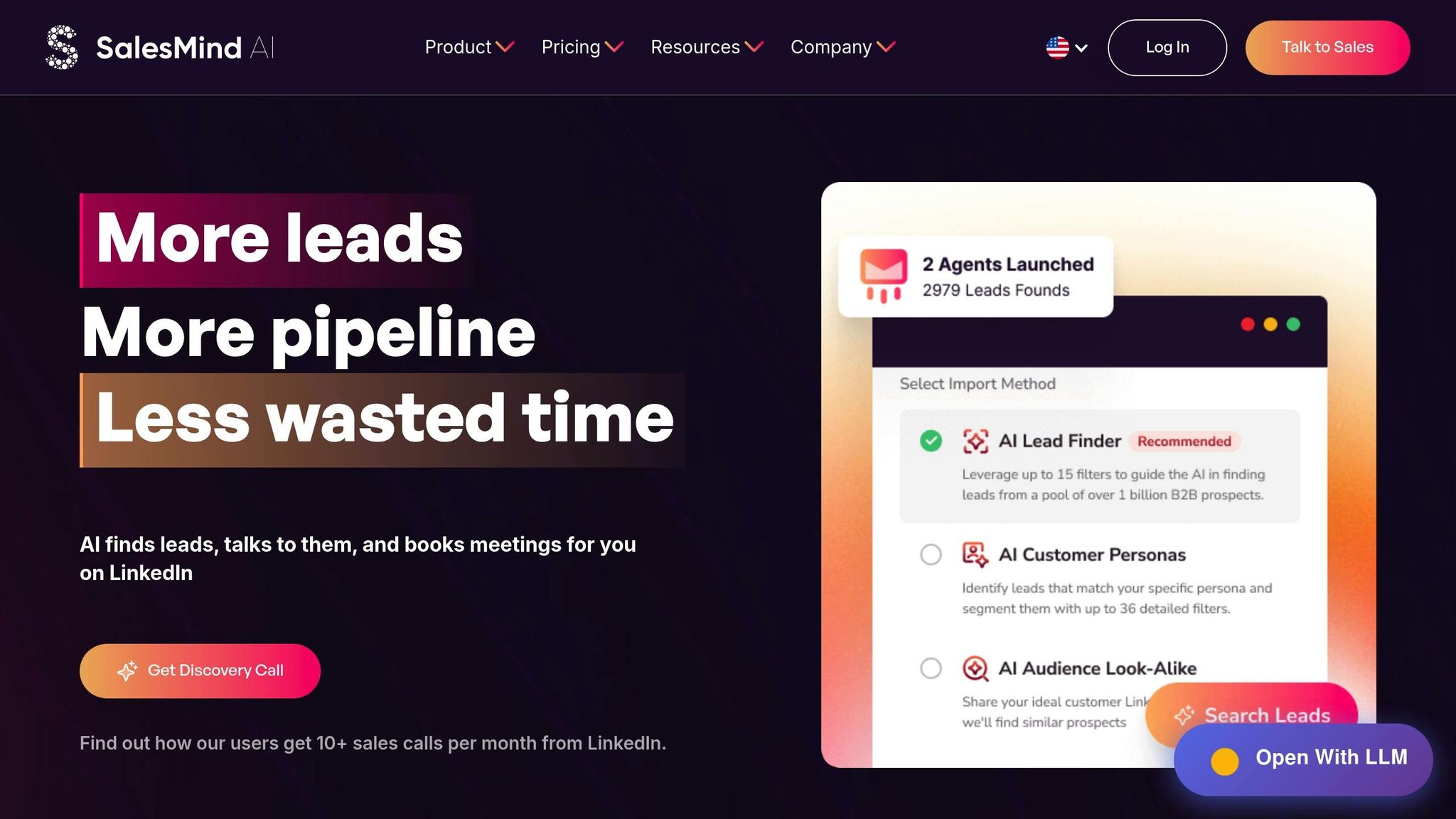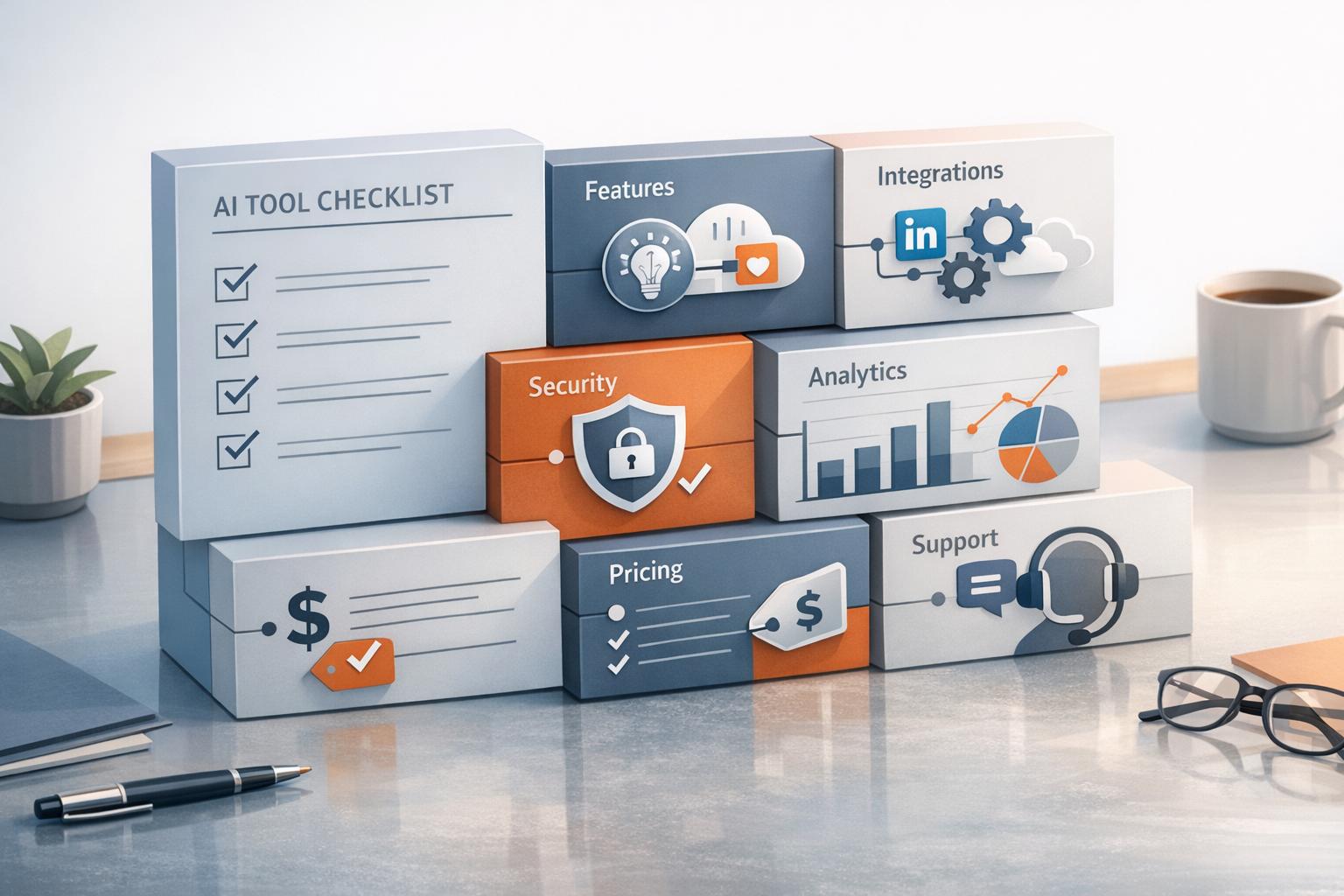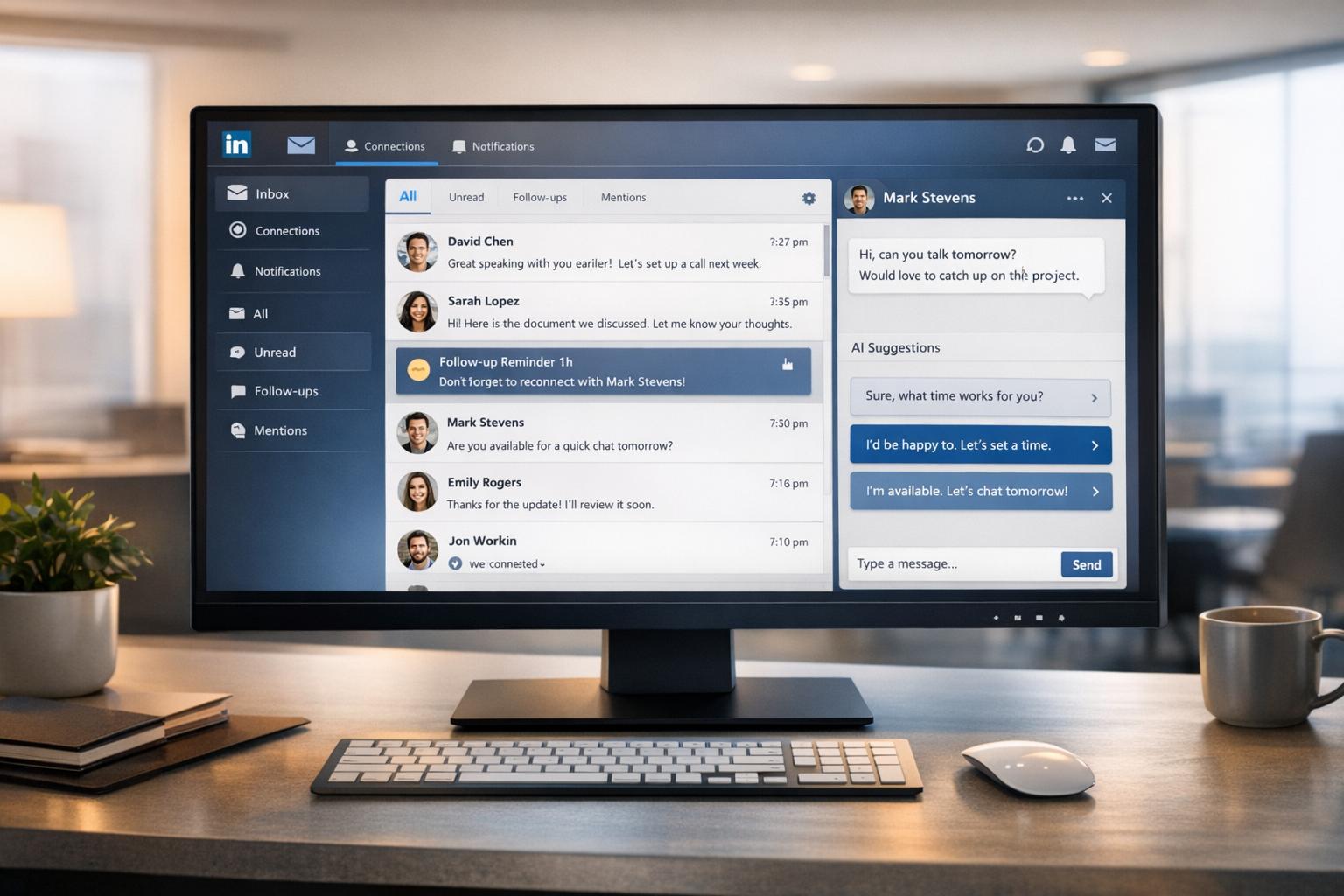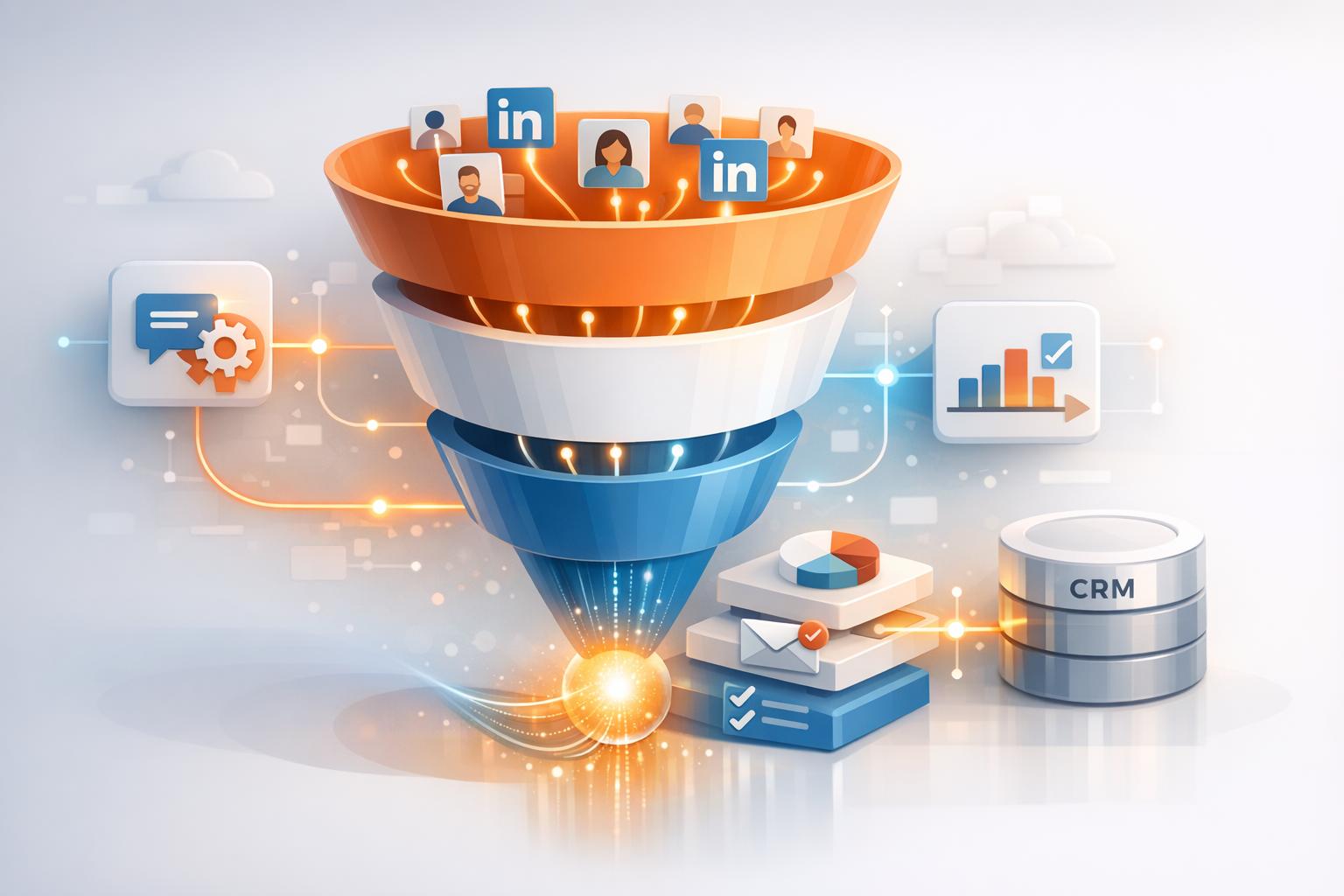
In SaaS sales, data segmentation divides customers into meaningful groups to improve lead management, personalize outreach, and boost conversions. Here's what you need to know:
- Why It Matters: Segmentation helps sales teams focus on high-value leads, tailor messaging, and improve key metrics like churn rate and lifetime value. Companies using segmentation report up to 760% revenue increases.
- Automation's Role: Tools like SalesMind AI streamline segmentation by automating lead scoring, LinkedIn outreach, and real-time updates, saving time and increasing efficiency.
- Segmentation Criteria: Use demographic, behavioral, technographic, value-based, and needs-based data for deeper insights. Combine these criteria for actionable results.
- Data Sources: CRM systems, in-app analytics, surveys, and tools like LinkedIn provide the necessary data.
- Implementation Steps: Define clear goals, audit and consolidate data, and use automation tools to scale efforts.
- Common Mistakes: Avoid over-segmenting, relying only on static data, or neglecting data hygiene. Regularly refine your strategy.
Segmentation Criteria and Data Sources
Types of Segmentation Criteria
When it comes to SaaS segmentation, there are five main criteria that can provide deep insights into your prospects and customers. Demographic and firmographic data lay the groundwork, focusing on details like company size, industry, annual revenue, and geographic location. These factors help sales teams fine-tune pricing strategies and differentiate between enterprise-level opportunities and smaller businesses.
Behavioral segmentation dives into how customers interact with your product. Metrics such as login frequency, feature adoption, time spent in the app, and engagement trends are key here. Conducting cohort analysis can also help identify retention patterns, providing valuable input for your segmentation efforts.
Technographic segmentation looks at the technology ecosystem your prospects rely on - everything from their devices and platforms to CRM systems and software integrations. This information is crucial for spotting technical needs and potential partnership opportunities.
Value-based segmentation focuses on financial contributions, using metrics like monthly recurring revenue (MRR), customer lifetime value (LTV), and overall profitability. This method helps prioritize high-value accounts and reveals upsell opportunities.
Lastly, needs-based segmentation groups prospects by their specific product requirements, pain points, and use cases. This approach allows for highly targeted messaging that addresses each segment’s unique challenges.
By combining these criteria - like pairing firmographic data with behavioral trends - you can uncover which companies are more likely to upgrade or churn. This layered approach yields more actionable insights than relying on a single data point alone[4]. Once you’ve established clear criteria, the next step is gathering the right data to populate your segments.
Data Collection Methods
SaaS companies have a variety of tools at their disposal for collecting segmentation data. These include CRM systems, in-app analytics, automated event tracking, surveys, third-party tools, and LinkedIn data.
- CRM systems act as a central repository for customer profiles, sales history, and interaction records, making them vital for tracking account-level data throughout the sales process.
- In-app analytics platforms capture real-time behavioral data, such as user actions, feature usage, and engagement patterns. This helps identify active users versus those at risk of churn.
- Automated event tracking monitors specific user behaviors, like completing onboarding steps or using premium features. This data supports product-led growth strategies and highlights expansion opportunities.
- Surveys and feedback forms provide self-reported insights into customer needs, satisfaction, and future requirements - filling in gaps that behavioral data might miss.
- Third-party enrichment tools add firmographic and technographic details to your customer data, offering a more complete view of a prospect’s business environment.
- Professional platforms like LinkedIn are invaluable for B2B SaaS segmentation. Tools like SalesMind AI use LinkedIn profile data to identify top prospects and personalize outreach. On average, users see a 40% acceptance rate and a 45% reply rate, with monthly pipeline values often reaching $100,000[1].
Account-Level vs User-Level Segmentation
Once you’ve collected your data, the decision between account-level and user-level segmentation becomes critical for shaping your sales strategy.
Account-level segmentation groups entire organizations based on attributes like company size, industry, or total contract value. This approach works well for enterprise sales, where deals involve multiple decision-makers and longer sales cycles. It’s especially useful for strategic planning, contract renewals, and identifying opportunities to expand within existing accounts.
User-level segmentation, on the other hand, zeroes in on individual behaviors and preferences within an organization. It tracks user engagement, roles, and influence on purchasing decisions. This detailed view is essential for creating personalized onboarding experiences, driving product-led growth, and identifying internal advocates who can champion your product.
Many successful SaaS companies use both methods in tandem. For example, they might segment accounts by industry and size, then refine these groups further based on individual roles and engagement levels. This dual approach enables strategic account management while delivering personalized experiences to individual users.
How to Segment SaaS Customers ( Part 1)
Checklist for Implementing Segmentation in SaaS Sales Funnels
Now that you understand segmentation criteria and data sources, it’s time to put that knowledge into action. This checklist will guide you through integrating segmentation into your SaaS sales funnel. A structured approach is key to aligning segmentation with your business goals and ensuring your data is accurate and actionable.
Define Segmentation Goals
Start by setting clear, measurable goals that directly address your key challenges - whether that's reducing churn, boosting upsell opportunities, or improving lead qualification. Your goals should align with your KPIs and be structured using frameworks like SMART (Specific, Measurable, Achievable, Relevant, Time-bound) or OKRs (Objectives and Key Results).
For example, a well-crafted goal might look like this:
"Reduce churn among new small business customers (1-50 employees) from 15% to 10% within six months by identifying at-risk behaviors within the first 30 days and implementing targeted onboarding strategies." [2]
Another example could involve identifying upsell opportunities by segmenting users based on how they adopt specific features. The key is to ensure your goals are tied to measurable results - whether it’s improving customer retention, driving feature adoption, or increasing lifetime value. Keep these goals flexible by reviewing and updating them quarterly as your business evolves. [2]
Audit and Consolidate Data Sources
A strong segmentation strategy begins with reliable data. Review all your customer data to ensure it’s complete, accurate, and aligned with your goals. Look for gaps like missing demographic details, outdated contact information, or inconsistent product usage metrics. [3]
For instance, your CRM might have robust company-level data but lack insights into individual user engagement, while your product analytics might track behavior but omit firmographic details. Address these gaps by implementing data validation rules, regular cleanup routines, and deduplication processes.
To streamline this, consolidate all data into a unified platform. Standardize formats, fill in missing information with targeted data collection, and set up automatic syncing across systems. Your goal is to create a single source of truth that gives you a complete and accurate view of each customer and prospect.
Use Tools for Automation and Scalability
In the fast-paced SaaS world, manual segmentation just doesn’t cut it. Automation tools can handle the heavy lifting, grouping leads based on firmographic, behavioral, and engagement data. These tools also enable personalized outreach at scale, ensuring timely and relevant interactions while freeing up your sales team to focus on high-value opportunities.
For instance, platforms like SalesMind AI excel at automating segmentation. They group leads automatically, enable tailored messaging, and continuously update segments as new data flows in from your CRM, marketing automation, or product analytics systems.
When choosing tools, look for platforms that offer features like lead scoring, unified inboxes, and detailed analytics. These capabilities allow you to refine your segments based on performance data and adapt your strategy as your business grows.
| Implementation Step | Key Actions | Expected Outcomes |
|---|---|---|
| Define Goals | Set SMART objectives, align with KPIs, and review quarterly | Clear focus, measurable targets, and team alignment |
| Audit Data | Review sources, fix inconsistencies, and unify platforms | Reliable data and a complete customer view |
| Automate Tools | Use automation platforms, enable real-time updates, and track results | Scalable segmentation, better efficiency, and consistent outcomes |
sbb-itb-817c6a5
Best Practices and Common Mistakes in Data Segmentation
Building on the segmentation checklist, these best practices and common errors can help fine-tune your approach. The goal is to strike a balance between precision and practicality for effective segmentation.
Best Practices for Data Segmentation
Focus on data quality.
Start with clean, consolidated data. Combine information from different sources into a single platform, and use automated tools to flag outdated or inconsistent entries. A reliable data foundation is essential for accurate segmentation.
Combine firmographic, behavioral, and value-based data.
The most effective segmentation strategies use a mix of data types. Firmographic data (like company size or industry), behavioral insights (such as login frequency or feature usage), and value-based metrics (like customer lifetime value or churn risk) provide a complete picture of your customers' needs and actions.
Use real-time feedback to refine segments.
Segmentation isn't a one-and-done process. Continuously track metrics like engagement and conversion rates, and use automation to adjust segments as new data comes in. This ensures your strategy stays aligned with changing customer behaviors and market trends.
Link segments to measurable KPIs.
Tie each segment to specific, measurable goals, such as reducing churn, increasing upsells, or improving lead qualification. This keeps your segmentation efforts focused and results-driven.
Common Mistakes to Avoid
Even with the best practices in place, certain pitfalls can derail your segmentation efforts. Here’s what to watch out for:
Over-segmenting your data.
Avoid creating too many micro-segments based on minor differences. Focus on building segments that are large enough to act on, accessible, and meaningful.
Ignoring data hygiene.
Outdated or inconsistent data leads to inaccurate segments. Without regular cleanup and validation, your personalization efforts may fall flat and waste valuable resources.
Relying only on static data.
Static attributes like company size or industry don’t capture changes in customer behavior over time. Incorporating dynamic data, such as purchase history or feature usage, keeps your segments relevant and actionable.
Treating segmentation as a one-time task.
Segmentation requires ongoing refinement to reflect evolving customer behavior and business objectives. Regular updates ensure your strategy remains effective.
Best Practices vs. Common Mistakes Comparison
| Best Practice | Common Mistake | Impact |
|---|---|---|
| Use multiple segmentation dimensions | Rely only on static demographic data | Multi-dimensional segmentation provides deeper insights. |
| Prioritize data quality and hygiene | Ignore data hygiene and validation | Clean data ensures accurate targeting. |
| Set clear, measurable goals | Use vague or unmeasurable objectives | Specific goals drive focused results. |
| Regularly refine segments | Treat segmentation as a one-time task | Continuous updates maintain relevance. |
| Focus on actionable, meaningful segments | Over-segment into too many small groups | Actionable segments enable effective personalization. |
| Incorporate real-time feedback loops | Fail to monitor segment performance | Ongoing monitoring improves accuracy. |
Effective segmentation requires balancing detail with practicality. Segments should be detailed enough to allow meaningful personalization but broad enough to justify the resources invested. By following these best practices and avoiding common mistakes, you can build a segmentation strategy that drives measurable success.
Tools and Solutions for Data Segmentation in SaaS Sales
When it comes to effective segmentation, having the right tools in place can make all the difference. Automation, analytics, and seamless integration are essential components that power modern segmentation strategies. Let’s dive into how SalesMind AI simplifies segmentation and explore other tools that support this process.
Using SalesMind AI for Effective Segmentation

SalesMind AI is a powerful platform designed to automate segmentation for B2B SaaS companies. It combines LinkedIn outreach automation with AI-driven lead scoring, making it easier to identify and engage with the right prospects. One standout feature is its unified inbox, which consolidates communications from multiple LinkedIn accounts. With AI-powered assistance for responses, tagging, and reminders, it eliminates the chaos of fragmented data and keeps everything in one place.
The platform’s lead scoring system evaluates factors like industry, company size, and engagement behavior to prioritize prospects automatically. This allows sales teams to focus on high-value leads without manually sorting through every contact. Plus, its insights enable personalized messaging at scale, saving time while still maintaining a human touch.
One user shared their experience, noting a significant improvement in results:
"SalesMind AI gives us a new channel in LinkedIn sales. As a marketing agency, we will be able to use SalesMind to get in touch with precise clients on LinkedIn and create as many conversations as we can. It cuts down the working time and helps us close the deals. Best B2B sales product I have ever used."
– Si Wen, Regional Business Manager, ADI Resourcing - IT Services
Another key advantage is its integration with CRM systems. This ensures that all segmentation data flows seamlessly into your existing workflows, maintaining consistency and enabling your team to act on insights without juggling multiple tools.
Additional Tools Supporting Segmentation
While SalesMind AI is excellent for automating outreach and lead scoring, other tools complement its capabilities and create a more complete segmentation ecosystem.
- CRM Systems: These platforms centralize customer data from various sources, providing a solid foundation for segmentation. They ensure that all team members have access to unified customer profiles, which makes collaboration easier.
- Analytics Platforms: Tools like these allow for cohort analysis, offering insights into segment behavior. For instance, you might discover that customers acquired through partnerships have a 25% higher retention rate after six months compared to those from paid ads. This kind of insight can shape more targeted acquisition strategies.
- Marketing Automation Tools: Once your segments are defined, these platforms can handle the execution. They deliver targeted campaigns, track engagement, and update segment membership based on user behavior. The key is to ensure these tools integrate seamlessly with your main segmentation platform.
- Data Visualization Tools: These make it easier to interpret complex segmentation patterns. Clear visuals can help communicate performance metrics across your organization, making it easier to gain support for segmentation initiatives.
Segmentation Tool Features Summary
A well-rounded tech stack can enhance every step of the segmentation process, from organizing data to delivering personalized campaigns. The table below highlights how different tools contribute to segmentation efforts:
| Feature | SalesMind AI | CRM Systems | Analytics Platforms |
|---|---|---|---|
| Automation | High | Moderate | Low |
| Lead Scoring | Advanced, AI-driven | Basic to advanced | Not primary function |
| Personalization | High | Moderate | Low |
| Data Integration | LinkedIn, CRM | Centralized customer data | Integrates with data sources |
| Real-Time Updates | Yes | Varies | Yes |
| Segmentation Criteria | Behavioral, firmographic, engagement | Firmographic, lifecycle | Behavioral, cohort |
| Outreach Automation | Yes | Limited | No |
The best results come from combining these tools rather than relying on just one. SalesMind AI shines in automation and personalization, making it ideal for executing segmentation strategies. CRM systems serve as the backbone for managing data and workflows, while analytics platforms provide the insights needed to fine-tune your approach over time.
When choosing tools, integration is key. Even the most well-thought-out segmentation strategy will fall short if your tools can’t share data effectively. Look for platforms with strong APIs, pre-built integrations, and the ability to adapt as your needs evolve.
Conclusion
Breaking down data into meaningful segments is at the heart of driving SaaS sales success. It sharpens customer understanding and powers targeted strategies. For instance, past strategies have shown that customers brought in through partnerships boast six-month retention rates that are 25% higher than those acquired via paid ads[2].
Automation plays a key role in scaling these efforts while keeping personalization intact. Tools like SalesMind AI illustrate this perfectly by blending AI-driven lead scoring with LinkedIn outreach automation. The results? Sales teams often report 40% acceptance rates and an impressive $100,000 in monthly pipeline value[1]. It’s a clear example of how smart tools can take segmentation strategies to the next level.
Taking a multi-faceted approach - combining firmographic data with behavioral insights - offers a richer understanding of customers. Adding technographic data to the mix further sharpens targeting efforts, ensuring precision in outreach.
But none of this works without solid data. Clean, well-organized information from multiple sources forms the backbone of any reliable analysis. With this strong foundation, companies can continuously refine their strategies and uncover new opportunities.
Segmentation isn’t a one-and-done task. It’s an ongoing process that evolves with market trends, shifting customer needs, and changing business goals. Quarterly reviews help keep strategies aligned with these changes, allowing companies to stay ahead. Businesses that embrace this iterative approach consistently outperform those stuck in static methods.
FAQs
What are the best ways to combine segmentation criteria for a more effective SaaS sales strategy?
To get the most out of your SaaS sales strategy, it’s all about combining segmentation criteria that truly reflect your audience’s behaviors, needs, and preferences. Start by grouping leads based on essentials like industry, company size, geographic location, and job roles. Once you’ve nailed down these basics, take it a step further by factoring in behavioral data - things like past interactions, purchase history, or engagement levels.
Why does this matter? Using multiple criteria together helps you craft sales funnels and messaging that feel tailored to each segment. For example, you’d likely approach decision-makers at small tech startups differently than you would mid-sized healthcare companies. The more specific your strategy, the more likely it is to resonate.
To make this process smoother, tools like SalesMind AI can be a game-changer. They automate lead qualification and segmentation, cutting down on time-consuming tasks so you can focus on building genuine connections with your most promising prospects.
What are the best practices to maintain clean data and avoid mistakes in SaaS sales segmentation?
Ensuring data accuracy and cleanliness is a must for effective SaaS sales segmentation. Start by conducting regular database audits. This means clearing out duplicates, fixing incomplete entries, and removing outdated information. A well-maintained database is the foundation for creating reliable and actionable segments.
Another key step is setting consistent data entry practices for your team. For instance, decide on standardized formats for fields like job titles, company names, and contact details. This reduces inconsistencies and ensures your data remains organized and accurate.
Lastly, take advantage of tools like SalesMind AI to simplify data management. With features like advanced lead scoring and automated follow-ups, these tools can handle repetitive tasks, giving you more time to craft personalized sales funnels that truly connect with your audience.
How does SalesMind AI work with CRM systems to improve data segmentation and outreach?
SalesMind AI works effortlessly with leading CRM systems, making it easier to refine your data segmentation and outreach efforts. By syncing directly with your CRM, it automates essential tasks such as lead qualification, crafting personalized messages, and managing follow-ups. This keeps your sales funnel running smoothly and ensures everything stays organized.
Key features like AI-driven lead scoring and a unified inbox allow you to focus on high-value prospects and connect with them at just the right moment. This not only simplifies your sales workflow but also boosts the effectiveness of your lead management process.


.avif)


